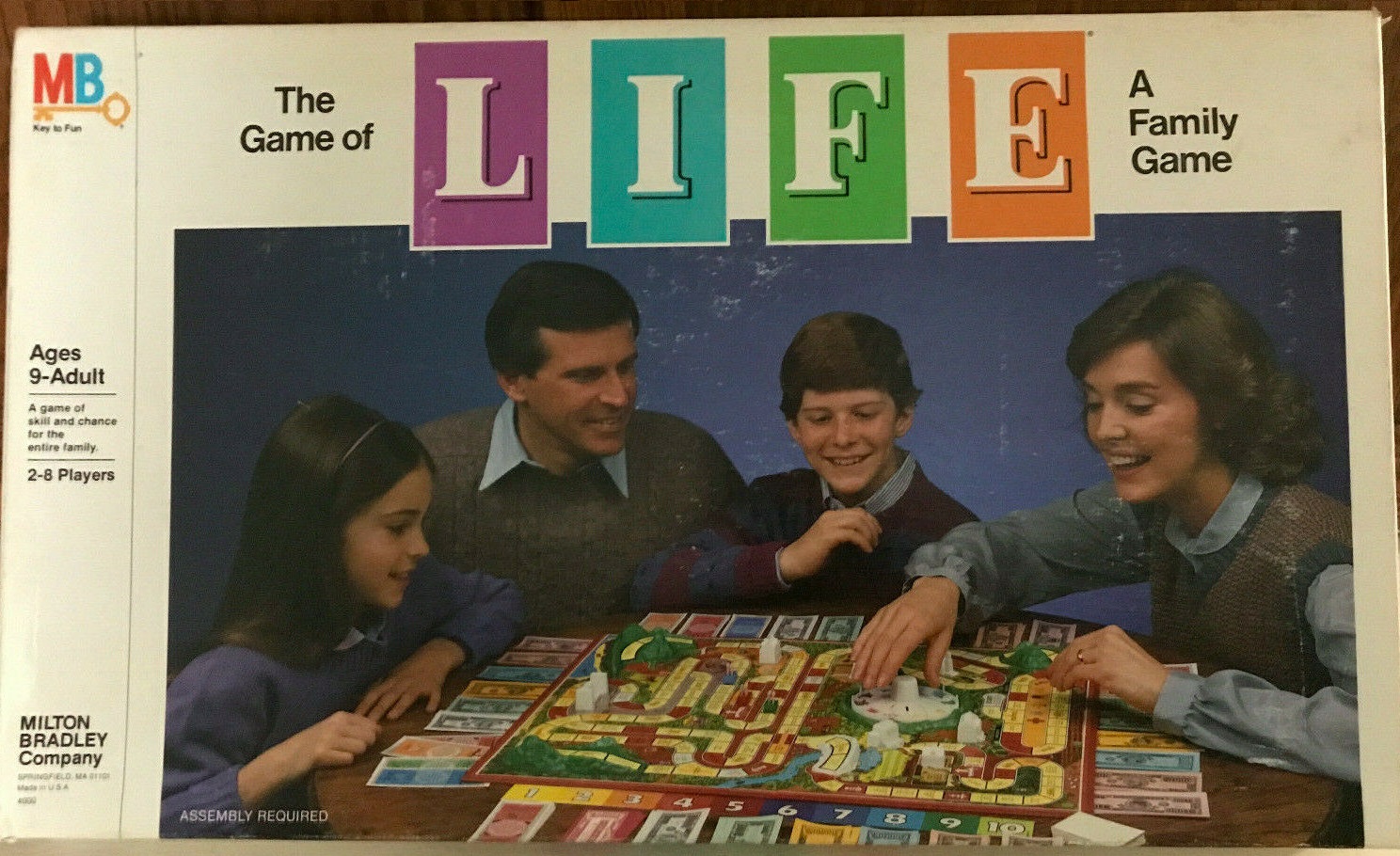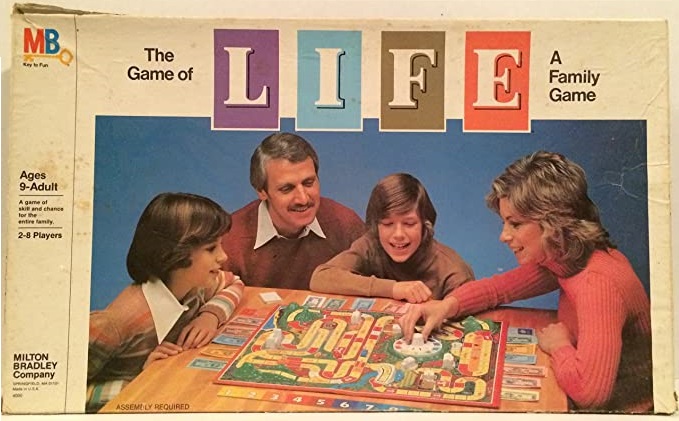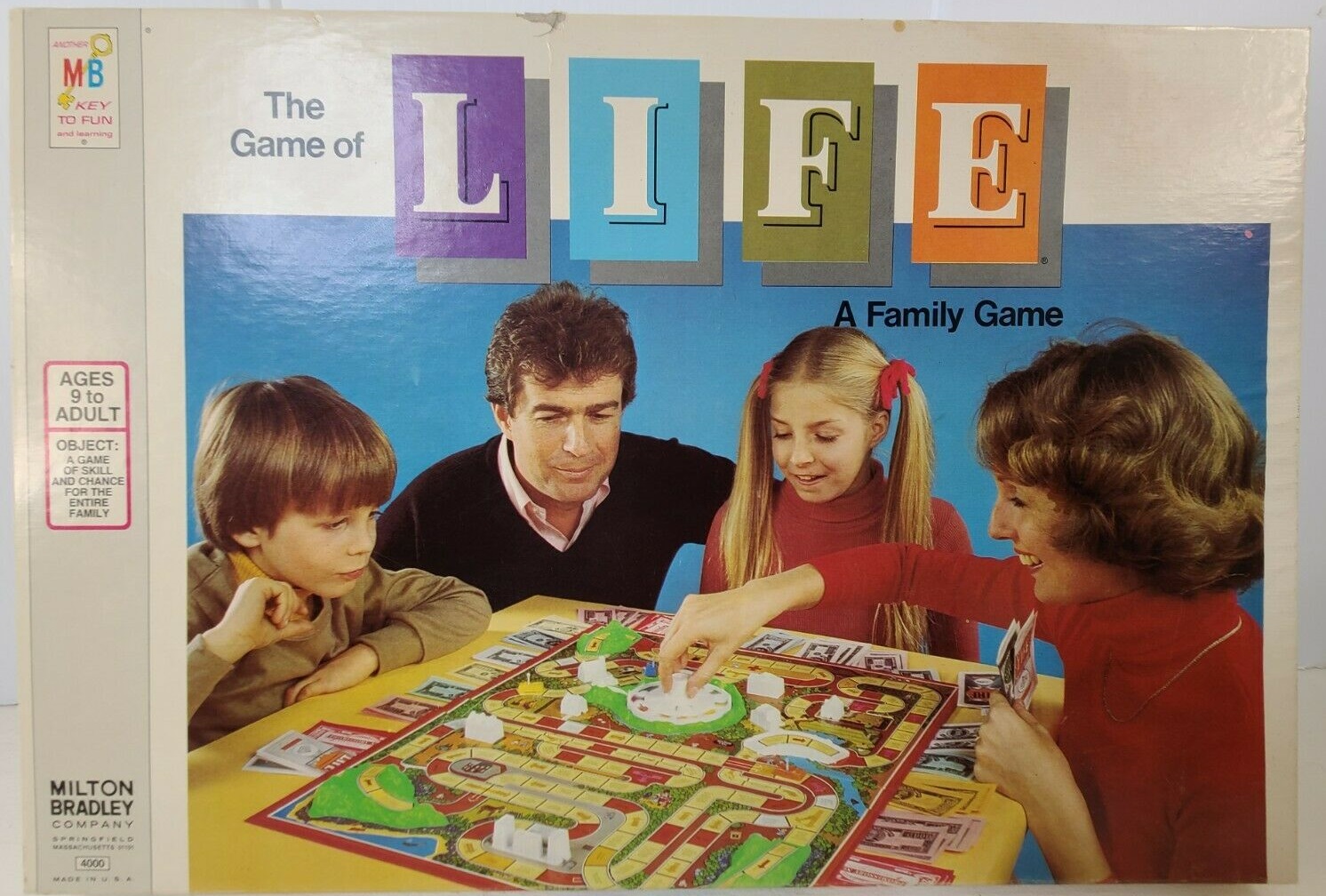Now that I’m a father of two in my 40’s, I often see the experiences of my children and am reminded of my own similar experiences from a long, long time ago.
There are some things about being a child that I miss.
I was obsessed with Christmas as a child, and having one Jewish parent and one Christian parent sure didn’t help this go unnoticed! But imagine twelve months of build-up? Six weeks of red-and-green lights, Christmas music, Christmas cookies, decorating the Christmas tree, Christmas-themes in school (back before everything fun was cancelled…), and just non-stop Christmas throwing up on you until that magic morning? Oh, the haul of gifts! To heck with the religious aspect; my 12-year-old self just wanted a new Noma GT Snow Racer!
I suppose not having to work for a living, pay bills, deal with adversity, family complications, and the realization that the world can be an awful place are also reasons to miss childhood.
But do you what I really miss?
Board games.
Yes, I know there are lots of board games for adults.
Those “drinking games” that you played, pre-pandemic. Apples to Apples, or the dirtier Cards Against Humanity. Those are fun.
I played Settlers of Cattan once with my wife and another couple. But then one of you gets too competitive, and the night is ruined.
Forget those adult games.
I’m talking about the games we played as kids.
We all had our favourites. We all had the ones we dreamed of getting for a birthday, for Christmas, or just for being a good kid when your Mom or Dad comes home and smacks it down on the kitchen counter in an Eatons or Simpsons bag.
Then there were the games that we felt we were supposed to play. They were advertised on TV and in magazines, and they seemed to infer that well-rounded, normal families played them. Like this one:
What a perfect family!
One boy, one girl. Probably named Bobby and Suzy.
The dad is “relaxing” on a Friday night by wearing a sweater over a dress shirt, and the mom probably just finished slaving over a hot stove and doing the dishes, putting the leftovers in this new thing called tupperware.
The kids don’t fight or argue and they brush their teeth before bed without being asked, and the same goes with saying their prayers. They never curse, and they have no problem doing household chores.
The parents are pillars of the community. The dad has worked for the same company for twenty-five years and they recently gave him a gold watch. The mom spends all day doing “housework,” wearing dresses, and is always smiling. She loves her life and has no regrets.
They’re just a typical family!
A family not unlike this family:
I guess the sweater/dress-shirt combo was readily available from 1976 through 1988?
Seemingly, yes…
Raise your hand if you felt pressure to at like one of these families growing up, because I sure did!
But then I discovered the television show Married With Children and realized that dysfunction is normal, but that too is a topic for another day…
Did you ever play Operation?
Not quite a board game per se, but the television ads were great. The only problem was: it wasn’t nearly as fun in person as it seemed in the ads.
Battleship? We all played it. And we all loved it. Even though it was 98% luck (where you placed your ships might have been classified as “skill”). I got Electronic Battleship in 1989 but my mother, who hated “waste,” didn’t like the idea that it wore out the batteries. So it became regular-Battleship.
I absolutely LOVED the board game Clue. But I also loved the movie, starring Tim Curry, Christopher Lloyd, and Michael McKean, among others. I would beg my friends to play Clue with me at indoor recess, but the game took longer than fifteen minutes so we’d never finish.
We all outgrew Snakes & Ladders by the time we realized there was no skill involved. Just rolling dice over and over.
Wheel of Fortune made an appearance sometime around 1988, I believe. You had to look up the letters in the back of a book, so it made the game-play really slow.
We all begged our parents to buy us Mouse Trap because of the epic commercial and accompanying song, which we all knew by heart. But the game was silly. We just liked to knock the ball in the rub-a-dub-tub which flipped the man into the pan…
Sorry to those who disagree, but I never cared for Sorry! Sorry!
I loved Mastermind. Especially the Mickey Mouse version that I was given for my 8th birthday. I kept it in mint condition. I liked any version of Memory too. The game Pizza Party was essentially Memory, but with a game-board in the form of a slice of pizza.
A lot of games were based on television shows, but they all sucked. Gi Joe, Masters of the Universe, Smurfs Ahoy, et al. But who the heck makes a game out of All My Children? That was in the cupboard of our third-grade class and it never got touched.
We all discovered Guess Who at some point, and it was really fun at first until you realized that only the cards featuring players without glasses, or facial hair, or a bald head were the ones you could ride to victory.
Then there were those weird games that nobody had, except for that one friend who seemed to have them all! Othello, Keeno, Parchesi, Uno, and the like. That one friend also had parents that outlawed cable television, so he only got CBC and maybe, if you were lucky, Global or CTV on a rainy night when you tilted the rabbit ears the right way…
So many games would be outlawed today. Imagine the game Dare nowadays, with the tagline, “How far will you go to win?”
I feel like the game Chicken Out and the associated peer pressure would render it cancelled by society. And don’t even get me started on Chinese Checkers…
But the game that I loved more than anything, and the game that I longed to play as a child, if only I could find somebody willing, was Monopoly. I would beg my little brother to play, or my older sister, or even my mom, who is probably reading this right now, feeling bad. But nobody wanted to play Monopoly.
Why?
It’s simply the greatest board game ever invented. There’s an element of luck, like all board games, but there’s strategy, and you get to negotiate with other players, and potentially joint-venture (or “gang up”…) to take other players out. From age-six, you learn about mortgages, rent, rates of interest, the cost of building houses and hotels and maintaining them if you happen to pick up the single-worst card in the game:
Yeah, that’s a bad one!
But you can get income tax refunds, collect life insurance, inherit money, bank error in your favour, benefit from sale of stock or the maturity of your Xmas fund, and even win second prize in a beauty contest, of all things!
Of course, you can also be forced to pay school tax, or a “poor tax” (imagine such a game in 2021??), but I think the pros outweigh the cons here.
I am of the opinion that children in public school today should be taught the game of Monopoly as a course starting in grade-six, and this should be revisited every year. I’m being serious here. We talk about financial literacy all the time on TRB and lament how young people today have no clue how to understand (let alone calculate…) compound interest, and yet in Monopoly, you have to decide between paying $200 or paying 15% of your net worth when you land on the “Income Tax” space.
So, let’s play a game!
Let’s play an interest rate game!
I assure you, the lead-in for today’s post wasn’t intended to be the actual post itself, but alas, here we are.
There’s been a lot of talk on TRB so far in 2021 about the low interest rate environment propping up the market, either as the cause of accelerating prices or merely one of the causes.
Say what you want on that front, and the opinions will vary.
But today, I wanted to work through an example of how interest rates play a role, and understand where you, the readers, think the breaking point is.
We’ll look not just at the monthly payments but also the breakdown of principal and interest, and ultimately you decide when a potential buyer would look at an investment as “affordable” and when that becomes “unaffordable.”
Assume we are buying a house for $1,000,000.
Our down payment is 20%.
The current variable rate mortgage is 1.35%.
As we all know, this is essentially free money. Those who don’t champion accelerating prices will suggest that this is the cause of appreciation in 2021, and that our market is not in a good place.
The monthly payment for this mortgage on a 25-year amortization is $3,142.01.
How do we determine if that’s affordable?
Many lenders use a GDS ratio, that is, gross debt service, which would include the mortgage, property taxes, and utilities (CMHC simply refers to “heat” but some lenders look at all utilities and/or insurance), as a percentage of gross income. Lenders use the mortgage stress test but to keep our game simple and as understandable as possible to those without financial backgrounds, let’s just use the interest rate as is.
In the above case, $3,142.01 per month, plus $400 for taxes, plus $200 for utilities, would bring us to $44,904.12 per year, so you’d need a gross income of between $106,900 and $128,297.
For two individuals making $53,450 per year or more, this is quite doable.
Now, what if the buyers took a 30-year amortization instead?
Well, now the monthly payment would drop to $2,702.31.
Thus the yearly commitment would $39,627.72, and thus the income needed to qualify would be between roughly $94,352 and $113,222.
Easy-peasy, right?
Let’s say the buyers go with a 5-year, fixed-rate of 1.59% that was attainable last month.
The monthly payments would increase from:
25-year amortization: $3,142.01 to $3,231.45
30-year amortization: $2,702.31 to $2,793.62
Oh, so who cares, right?
On a 30-year amortization, we’re talking an extra $91.31 per month?
And what does this do the affordability, using the same 35% – 42% GDS ratios?
We go from a qualifying household income of $94,352 – $113,222 to a qualifying household income of $96,961 – $116,352.
Meh.
Alright, we’ll let’s say the interest rate jumps to 1.99%.
Now we’re looking at a 25-year amortization payment of $3,383.75 and a 30-year amortization payment of $2,949.68.
So continuing with the 30-year amortization, our household income now must be between $101,419 and $121,703.
Alright.
What if rates increase to 2.99% on a 30-year amortization?
Now our monthly payment is $3,360.57. That’s a long way from the $2,702.31 that we were paying on a variable at 1.35%, right? Or, maybe it’s not. Maybe $550 per month isn’t anything to write home about for you. But can you say the same for the person standing next to you?
And if rates hit 3.99% on a 30-year amortization?
Now our monthly payment is $3,799.62.
And it takes between $125,703 and $150,844 of household income to qualify, as opposed to the mere $94,352 to $113,222 that was needed on a 1.35% variable for 30 years.
Again, maybe there’s no real difference between $95K and $125K for some people, but for others, there will be.
Personally, I think there’s a very small chance that we see 5-year rates over 4% in the next five or six years (disagree if you want), so I’ll stop the interest rate game here.
But I’ve only looked at this from the perspectives of monthly payments and household income qualifications.
What about the forced savings?
The unsung hero in this market is the automatic paydown of principal!
In our example where you have a $1,000,000 purchase with a 20% down payment, and a variable rate of 1.35%, the monthly payments are:
25-year: $3,142.01
30-year: $2,702.31
What’s the breakdown of principal and interest paid each month in, say, year-one?
25-year: $2,258 of principal, $884 in interest
30-year: $1,816 of principal, $886 in interest
Now how about on that 1.59%, five-year fixed?
25-year: $2,191 of principal, $1,041 in interest
30-year: $1,750 of principal, $1,044 in interest
And on the 1.99%, five-year fixed?
25-year: $2,081 of principal, $1,302 in interest
30-year: $1,643 of principal, $1,306 in interest
Now on the 2.49%:
25-year: $1,950 of principal, $1,629 in interest
30-year: $1,517 of principal, $1,634 in interest
And the 2.99%:
25-year: $1,826 of principal, $1,956 in interest
30-year: $1,398 of principal, $1,962 in interest
Last, but not least, how does the principal and interest break down on a historically-low, but unimaginable-in-2021 rate of 3.99?
25-year: $1,594 of principal, $2,609 in interest
30-year: $1,183 of principal, $2,617 in interest
For those TRB readers who only come here for the MLS Musings or to watch me get ripped in the comments section, I probably lost you a long time ago. But for those without backgrounds in finance who are still reading this, you ask, what is my point?
Well, in addition to having your monthly payment jump from $2,702.31 on a 1.35% variable rate, 30-year amortization to $3,799.62 on a 3.99% rate for the same amortization, you’re also paying way more each month in interest.
You go from paying $886 per month in interest on the 1.35% rate to $2,617 per month in interest on the 3.99% rate.
During the course of five years, here’s how your total mortgage payments would break down:
1.35% rate
Principal: $111,953
Interest: $50,186
3.99% rate:
Principal: $76,921
Interest: $151,057
To the folks looking at buying real estate right now: does any of this affect your decision?
If not, is it that you’re only looking at the monthly payments or that you aren’t concerned about the potential for a 3.99% interest rate?
I can make an argument either way here, and I know the readers will have no shortage of thoughts on this.
I understand, more now in 2021 than ever before, that many buyers view the purchase of real estate as buying a payment plan and not buying a house that they expect to own free and clear one day. But others see their monthly mortgage payment as a form of forced savings, and when you’re at 1.35% on a variable, and you’re paying $111,953 of your $162,139 in total payments over five years back into your own pocket, then buying and owning real estate is an absolute no-brainer.
But then what about when you’re only paying $76,921 of your $227,978 in payments back to yourself?
Are we so far away from 3.99% rates that nobody cares?




































Francesca
at 7:51 am
David, you brought back fond memories of my childhood too. I absolutely love clue both the board game and the movie which btw I can not seem to find on any streaming service to show my teenage daughter who also loves the board game. You forgot to mention Yahtzee! Do you know that my daughter learned her multiplications by playing Yahtzee at a young age. She was a master at school thanks to this game so I think along with monopoly kids should play this too.
Monopoly can take hours to play. Probably the reason why you found so much resistance from your family to play it.
As for your interest rate topic today. I think it totally matters. When we first purchased a house back in 2009 I believe our fixed five year rate was 3.68. My husband was so fixated on how much money we were wasting in his mind paying off the interest that he made it a goal to pay off our mortgage as fast as we could. Every year we made lump payments to decrease the mortgage and paid it off in four years. In today’s situation, yes we would have paid way more for the house, but with interest rates so low at least you are paying off more principal so I don’t think we would have been as motivated to pay it off so quickly!
Sirgruper
at 8:34 am
Thought you’d also be a Stock Ticker guy too or may that’s Chris. If you wanted fake family dispute there was popamatic Trouble. Loved Battling Tops actual and my wealthy friend had Rockem Sockem Robots. So jealous. Funny the way rates can move quickly. I remember 2% in a day. Scary to take a 80% mortgage with prices like they are but not a big choice if you have no backstop. Ps. Mousetrap. Don’t know anyone who actually played it, just built it(and it almost always failed). Thanks for the memories.
Whaaa?
at 12:05 am
Battling tops! Yes! My brothers and I played it for hours on end.
IK
at 8:35 am
Oh how I long for the times when I didn’t have to scroll through the first half of your posts, David. Maybe one day I’ll get to experience such joy again. Maybe…
Jimbo
at 9:21 am
My opinion is people only care about the payment and what they can qaulify for. I have had this opinion since 2010, before that I honestly thought people cared about the ratio of interest to principal.
In every case, your home is paid off in 25/30 years; provided you are not remortgaging for stupid things like cars, cosmetic upgrades etc. Smart things would include remortgaging for a rental property or to fix structural issues with your current house.
Something I brought up in a comment in 2018 was the fact that a home in 1989 cost the same as a home in 2016 in absolute costs. Yes, the house was $280 something thousand, but after 25 years at that interest rate it was the same as a $750k house at 2% interest. In the end when you took interest paid with principal the cost was the exact same…….
???????????? NOW HERE IS THE THING ????????????
The people that bought in 1989 had a falling interest rate environment, which meant they didn’t actually have to pay as much for their house in the end, but this was not a known fact when they bought. We will not have that same luxury. Another factor they had was an increasing wage because of inflation and promotion with a falling interest rate lowering their home payment at the same time.
Current homeowners will not have that same benefit, yes their wages should grow, but their payment will not go lower. They are stuck with that same payment going forward. Now if rates so go up, their payment will increase and so to will the overall cost of the home.
Banks rely on increasing mortgage origination for growth, if rates go up this week slow down. Their upside is the increased profit in interest, which will offset that “loss”.
I’m not sure what will happen with interest rates going forward, but I would like to point one thing out. In 1996 our country debt to GDP ratio was 65% and nobody would “loan” Canada money. That is why Paul Martin cut so many services. In the last year our debt to GDP ratio went from 30% to 50%. This really limits how high they can raise rates without hurting Canada, but they will need to raise rates to make our bonds valuable enough to buy in order to support our economy.
Very interesting times in deed.
I also can’t see rates go above 5% in the next 6 years; who knows what will happen if we can’t get back to normal soon and if normal will be good enough to grow the GDP.
Pragma
at 11:35 am
Excellent post. Buying a house is nothing like buying a house 20 years ago. That tailwind of lower rates are gone. Even if the payment is the same, the ability to pay down the principal is not. Going all in on a house has been a great trade over the last 20 years, I don’t think it’s that compelling of trade at all in today’s environment.
Jimbo
at 6:31 am
The principal payment is large enough to make a significant dent in the mortgage and build up equity quicker than anytime in the past.
This has been a benefit to the owner; as a society we have proven we are willing to buy a house by paying the bank 7X in interest and X in principal each month. We did it through a portion of the 80’s and early 90’s. (Maybe it was 10X)
I don’t know how society would react to paying a 6% rate (even if I assume the payment can be made easily each month) have we grown so accustomed to half our payment going to principal that anything less would be unconscionable? It would be like paying $3 for milk and then next year they want $21 for that milk. I’m not sure if our psyche could handle that. Progressively grow to 6% over 10 years, we wouldn’t even notice.
Average Joe
at 3:03 pm
I agree. I think the “soft landing” many banks and economists are calling for is a euphemism for dead money. With prices elevated compared to rent and growth tracking sideways for a while there won’t be a very strong impulse to buy for many people. The only way out is to let inflation and wages overheat for a while and burnoff the excess debt load until the rest of the economy catches up.
Appraiser
at 4:08 pm
Over 6,800 sales on TRREB in the first 15 days of March says otherwise.
We are on a rocket-ship headed straight for another all-time record for sales.
But great “analysis” otherwise.
Average Joe
at 4:24 pm
David is pontificating over the next five years in his article, not the next five days. Asset markets are pretty hot right now. Any other breaking news for us?
Appraiser
at 8:00 pm
You wrote that you agree with Pragma, who wrote ” I don’t think it’s that compelling of trade at all in today’s environment.
Help me out here. Today’s environment is hot as hell and more people than ever in the history of the GTA are making that “trade”.
How about dealing with what we know – the here and now?
Jimbo
at 6:23 am
I believe people will buy because there are not enough rentals and there will always be people that need to sell. I think there will come a time where the only increase in housing is tied to wage inflation because with interest rates at the lowest levels we eventually top out interest rate derived growth. If amortizations are increased, it gives another opportunity for house price growth.
Sales numbers should remain at the long term average at least.
Daniel
at 9:25 am
You forgot Connect Four! Nobody plays that game without arguing!
Appraiser
at 10:08 am
Congratulations to all of those who recently locked in their financing for the next 5 or 10 years at recent historic lows.
P.S. Rates are still really really low.
And a big shout out to all the sellers who have managed to cash-out of this market to retire and or move out of the GTA.
Also kudos to all those lucky buyers who purchased a new construction property many months ago at a locked-in price and will soon be or have recently sold their existing property.
Chris
at 10:31 am
And finally, a pat on the back to all those who bought or held their equity positions over this past year. Even a dead-easy investment in a one-fund portfolio, such as VBAL, is up 30.6% YoY as of this morning!
J
at 12:40 pm
The GDS ratio seems to be a joke of a qualification measure. The first example from above with $44,904 in expenses requires two incomes of $53,450. After taxes and CPP/EI, each one brings home $41,456 or $82,912. This leaves just $38,008 ($3,167/month) for everything other than mortgage, utilities and property taxes.
But that’s only if the income is evenly distributed between the couple. Progressive tax rates will reduce the total net income if one person earns more. Also, the $44,904 figure is missing significant other housing costs including maintenance/condo fees and insurance.
The stress test helps somewhat with determining realistic affordability, but it’s designed to shield against the possibility of rising interest rates, not immediate affordability issues.
For an $800k mortgage on a $1M property, my gut feeling is that a household income of at least $200k-$300k is needed to live anything beyond a student lifestyle.
Marty
at 1:22 pm
Sure, Mastermind™ was an OK game, but it hardly exposed your “master mind”.
It was a pretty limited skill set to work out the coloured pins in the right order, or whatever it was, now I forget.
Condodweller
at 4:18 pm
If we accept the notion that interest rates are a major determinant of housing prices, and the other one being jobs/income also remaining fairly constant after adjusting for inflation, with the two being inversely correlated (rates/prices), it should be fairly straight forward to reverse engineer future prices if rates continue to rise and return to long term averages. All we have to do is look back over the past 30 years as rates declined from about 13% to ~1.5%. Just take a long term interest rate chart and put a mirror at today.
The million $ question of course is where interest rates are headed? Assuming the Bank of Canada is not going to reduce rates any further as they indicated from the current 0.25%, it can by definition only increase. The next question is by how much and how fast.
I’m very skeptical when banks start calling people to lock up fixed mortgages.
I’m curious if the recent rise in bonds is sustainable and if the Bank of Canad’s hands will be forced by the economy.
Cool Koshur
at 5:38 pm
David,
Sorry. You analogy is wrong. Pick a affordability calculator
https://tools.td.com/mortgage-affordability-calculator/
and for couple making $1,10,000 and with 200,000 down can afford a house of $738,000 (presumption is $2300 for expenses other than house like groceries, transportation, car payments, insurance etc)
First issue is coming up with 200K down who has that kind of money particularly first time buyers. Second what are you going to get for $738,000 in GTA… Condo or may be townhouse in not so desirable neighborhood. Entry point into GTA housing market is pretty high. Instead of putting $200,000 as down payment. I would rather setup RESP for kids which comes with 20% return from matching contribution. Contribute to RRSP with 30% return in tax savings and rest into TFSA for returns in equity market which is doing well.
Low interest rate is a good incentive. But families cant service the loan. unless you are investor who is tapping into HELOC and buying rental properties. Home ownership train has left station more than 5 years ago. Whoever hopped on it are doing good. Rest will be renters for probably rest of their lives.
Condodweller
at 9:55 pm
I see parents putting up the down payment for kids and immigrants frequently show up in Canada with a few hundreds of thousands of $$ so downpayment is only a concern if you have to earn it for yourself. Are we going to see parents subsidizing mortgage payments for their kids as well? They might need to the way pricing is going.
Cool Koshur
at 11:04 pm
Makes sense. Bank of Mom & Dad. (baby boomers) are loaded. They do provide the ladder. New immigrants typically South Asians are culturally inclined to own the home rather than rent. Third category are those who are upscaling and are using equity from their current homes. Fourth category are investors who rents units and then after couple of years for a neat profit. Fifth is flippers who renovate for quick profit